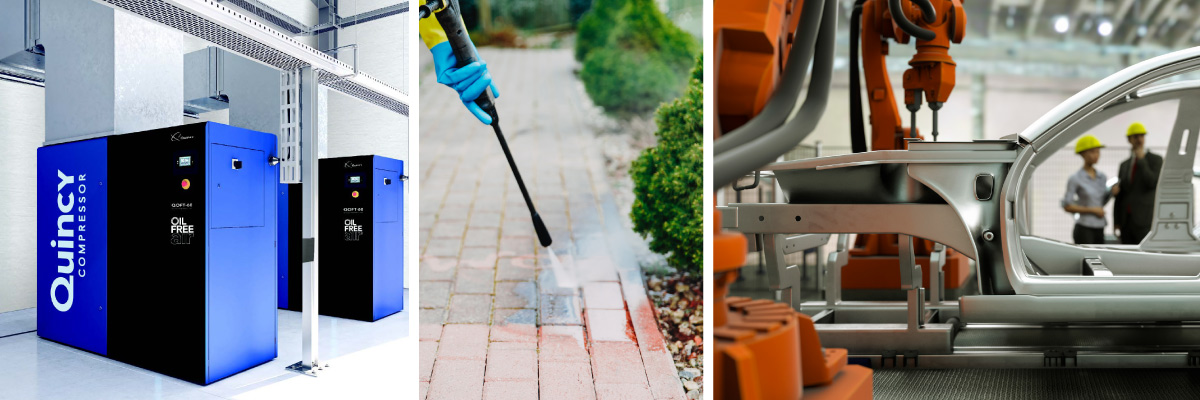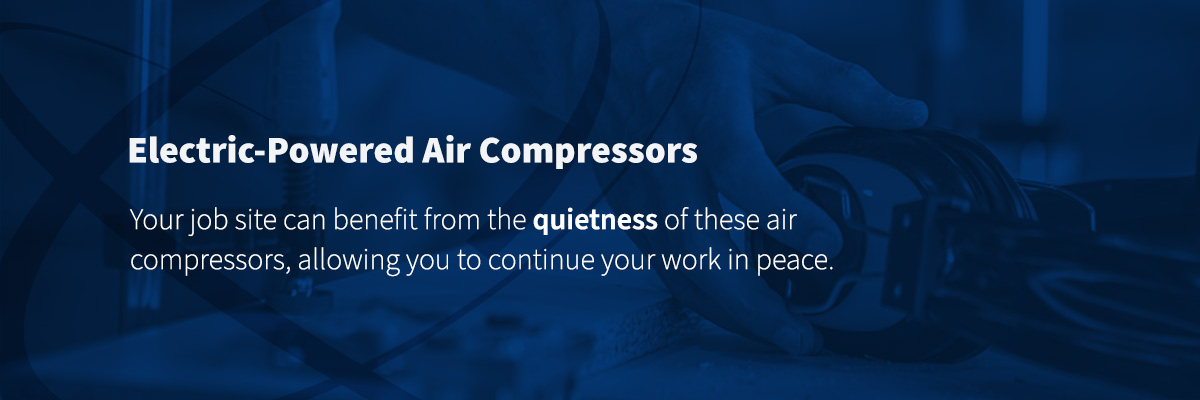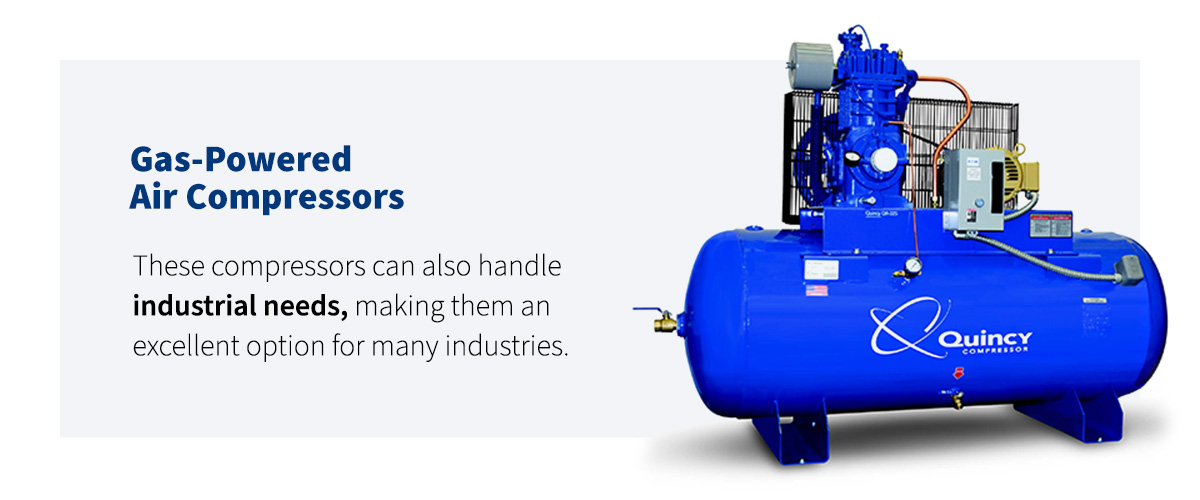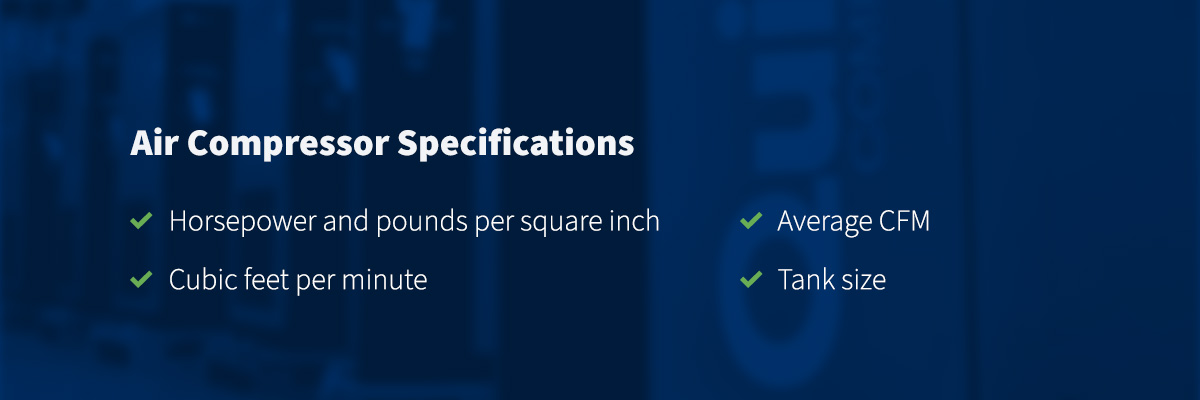Chapter 2: Air Compressor Power Sources and Specifications

Every air compressor relies on a power source and comes with different specifications to help you determine if they’re suitable for your needs. Some industries need a heavy-duty air compressor, while others only require something smaller yet portable. Understanding the two primary power sources and specifications can help you make an informed decision when purchasing your next air compressor. This chapter guides you through the two power sources for air compressors and the different specs to look for before purchasing one for your work.
Electric-Powered Air Compressors
Electric-powered air compressors rely on electricity, as the name implies. People often use these compressors inside, where electrical outlets are more common. Some of the benefits of choosing electric air compressors include:
- Portability: Electric-powered air compressors are generally portable, allowing you to take them from one location to the next. However, they have limited mobility, meaning you can’t take them everywhere with you. These electric-powered air compressors require at least a 120-volt household current, so ensure your location has the proper setup before purchasing this type of compressor.
- Quietness: On top of being portable, electric-powered air compressors are also very quiet compared to gas-powered compressors, primarily due to the absence of a gas-powered motor. Your job site can benefit from the quietness of these air compressors, allowing you to continue your work in peace.
- Tendency to have better air quality: In most cases, electric compressors provide superior air quality since they don’t rely on gas or oil. As a result, there is less risk of contamination, which could impact the compressed air quality. Electric-powered compressors are your best option if you want consistent, high-quality pressurized airflow.
- Commonality: These air compressors are simpler to operate and require less maintenance than other models. The easy function and minimal requirement of a 120-volt outlet for some models make them more common for many industries, especially those in enclosed spaces, meaning it can be easy to find an electric-powered air compressor that suits your budget and needs.
While electric-powered air compressors are an excellent option if you have access to an outlet, some job sites don’t always have these outlets readily available. Electric air compressors are useless without these outlets, so you’ll want to know what is available at your job site before choosing this type of air compressor.
Gas-Powered Air Compressors
Gas compressors rely on a fuel source, typically gasoline or oil. These compressors are usually used in outdoor settings as indoor work with a gas-powered compressor can be dangerous for the people inside. Before you buy one of these compressors, there are a few things you should know about gas-powered air compressors:
- Large and hard to move: Gas-powered air compressors tend to be larger than electric-powered compressors, making them heavier and harder to move. The lack of mobility can be detrimental to some work sites that need to move their air compressors consistently. However, if your job site only requires an air compressor in a few select locations, gas-powered compressors can provide you with the air pressure you need to get the job done.
- Noisy: Gas air compressors often use a loud motor, distracting workers and others nearby. This further limits these compressors to outdoor settings where the noise won’t bother as many people or the environment.
- Efficient, heavy-duty and suitable for industrial applications: You can recover the waste heat these compressors generate and use it for other means, making gas-powered air compressors an efficient tool. These compressors can also handle industrial needs, making them an excellent option for many industries. Their efficiency and heavy-duty applications make these air compressors stand out against electric-powered compressors in specific sectors.
If you’re trying to decide between an electric- or gas-powered option, consider the functions of air compressors in your industry. Will you predominantly be using the compressor indoors? Do you need to move the compressor around consistently? What is the standard in your line of work? These questions and others can help you make a final decision. On top of the function, you’ll also want to consider what features of air compressors are essential to your field.
Air Compressor Specifications
Each air compressor model has different specifications. Knowing these specifications is essential to ensure you choose the right fit for your needs. Some air compressor specs you should look for include:
- Horsepower and pounds per square inch: Horsepower ratings help determine how much power the air compressor’s motor can produce. The higher the horsepower, the more air pressure the compressor can generate. The air pressure is measured in pounds per square inch (PSI). Most compressors have a limit on the PSI they can produce. For example, single-stage compressors can only reach 125 PSI. A higher PSI generally allows you to use the air compressor for extended periods. Additionally, many compressors with a higher PSI will switch off on their own once they’ve reached maximum air pressure inside the tank.
- Cubic feet per minute: Cubic feet per minute (CFM) refers to the machine’s ability to compress a specific volume or air at a set PSI. Your air compressor’s CFM will be higher when your PSI is lower. When looking for an air compressor, you’ll want to consider what CFM rating your air tools need. Then, you’ll add about 50% to the required CFM to ensure it can provide the appropriate air compression you need.
- Average CFM: The average CFM refers to the air tool rating that measures intermittent use, usually a 25% duty cycle. This rating is best utilized for tools that aren’t used continuously, as those you use frequently require more calculations to determine the necessary CFM for continuous use. If you want to use your air tools constantly, you can try multiplying the CFM average by four to estimate what rating you’ll need for continuous use.
- Tank size: The tank’s size is the amount of pressurized air you can have at once. Many manufacturers will mark this number in gallons, with smaller tanks ranging from four to six gallons. The tank size you need will depend on the compressed air you need on your job site. For example, industrial applications often need bigger tanks to complete large-scale jobs.
The specifications of an air compressor will help you make an informed decision on your next purchase. Carefully consider your needs before choosing a model so you don’t have to worry about making an unnecessary secondary purchase.
If you’re looking for a new air compressor, whether electric or gas-powered, find a Quincy Compressor sales and service location near you!




